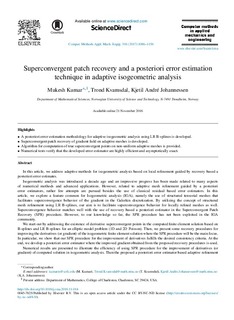| dc.contributor.author | Kumar, Mukesh | |
| dc.contributor.author | Kvamsdal, Trond | |
| dc.contributor.author | Johannessen, Kjetil Andre | |
| dc.date.accessioned | 2018-03-06T14:07:13Z | |
| dc.date.available | 2018-03-06T14:07:13Z | |
| dc.date.created | 2016-12-16T09:46:20Z | |
| dc.date.issued | 2016 | |
| dc.identifier.citation | Computer Methods in Applied Mechanics and Engineering. 2016, 316, 1086-1156. | nb_NO |
| dc.identifier.issn | 0045-7825 | |
| dc.identifier.uri | http://hdl.handle.net/11250/2488956 | |
| dc.description.abstract | Highlights • A posteriori error estimation methodology for adaptive isogeometric analysis using LR B-splines is developed. • Superconvergent patch recovery of gradient field on adaptive meshes is developed. • Algorithm for computation of true superconvergent points on non-uniform adaptive meshes is provided. • Numerical tests verify that the developed error estimator are highly efficient and asymptotically exact. Abstract In this article, we address adaptive methods for isogeometric analysis based on local refinement guided by recovery based a posteriori error estimates. Isogeometric analysis was introduced a decade ago and an impressive progress has been made related to many aspects of numerical methods and advanced applications. However, related to adaptive mesh refinement guided by a posteriori error estimators, rather few attempts are pursued besides the use of classical residual based error estimators. In this article, we explore a feature common for Isogeometric analysis (IGA), namely the use of structured tensorial meshes that facilitates superconvergence behavior of the gradient in the Galerkin discretization. By utilizing the concept of structured mesh refinement using LR B-splines, our aim is to facilitate superconvergence behavior for locally refined meshes as well. Superconvergence behavior matches well with the use of recovery based a posteriori estimator in the Superconvergent Patch Recovery (SPR) procedure. However, to our knowledge so far, the SPR procedure has not been exploited in the IGA community. We start out by addressing the existence of derivative superconvergent points in the computed finite element solution based on B-splines and LR B-splines for an elliptic model problem (1D and 2D Poisson). Then, we present some recovery procedures for improving the derivatives (or gradient) of the isogeometric finite element solution where the SPR procedure will be the main focus. In particular, we show that our SPR procedure for the improvement of derivatives fulfills the desired consistency criteria. At the end, we develop a posteriori error estimator where the improved gradient obtained from the proposed recovery procedures is used. Numerical results are presented to illustrate the efficiency of using SPR procedure for the improvement of derivatives (or gradient) of computed solution in isogeometric analysis. Then the proposed a posteriori error estimator based adaptive refinement methodology is tested to solve smooth and non-smooth elliptic benchmark problems. The focus is put on whether optimal convergence rates are obtained in the computed solution or not, as well as the effectivity index of the proposed error estimators. | nb_NO |
| dc.language.iso | eng | nb_NO |
| dc.publisher | Elsevier | nb_NO |
| dc.relation.uri | http://www.sciencedirect.com/science/article/pii/S0045782516315389 | |
| dc.rights | Attribution-NonCommercial-NoDerivatives 4.0 Internasjonal | * |
| dc.rights.uri | http://creativecommons.org/licenses/by-nc-nd/4.0/deed.no | * |
| dc.subject | Isogeometri | nb_NO |
| dc.subject | Isogeometry | nb_NO |
| dc.subject | Numeriske metoder | nb_NO |
| dc.subject | Numerical methods | nb_NO |
| dc.subject | Elementmetoder | nb_NO |
| dc.subject | Finite element methods | nb_NO |
| dc.subject | Feilestimering | nb_NO |
| dc.subject | Error estimation | nb_NO |
| dc.title | Superconvergent patch recovery and a posteriori error estimation technique in adaptive isogeometric analysis | nb_NO |
| dc.type | Journal article | nb_NO |
| dc.type | Peer reviewed | nb_NO |
| dc.description.version | publishedVersion | nb_NO |
| dc.subject.nsi | VDP::Anvendt matematikk: 413 | nb_NO |
| dc.subject.nsi | VDP::Applied mathematics: 413 | nb_NO |
| dc.source.pagenumber | 1086-1156 | nb_NO |
| dc.source.volume | 316 | nb_NO |
| dc.source.journal | Computer Methods in Applied Mechanics and Engineering | nb_NO |
| dc.identifier.doi | 10.1016/j.cma.2016.11.014 | |
| dc.identifier.cristin | 1413786 | |
| dc.relation.project | Norges forskningsråd: 187993 | nb_NO |
| dc.relation.project | Norges forskningsråd: 193823 | nb_NO |
| dc.description.localcode | Published by Elsevier B.V. This is an open access article under the CC BY-NC-ND license (http://creativecommons.org/licenses/ by-nc-nd/4.0/). | nb_NO |
| cristin.unitcode | 194,63,15,0 | |
| cristin.unitname | Institutt for matematiske fag | |
| cristin.ispublished | true | |
| cristin.fulltext | original | |
| cristin.qualitycode | 2 | |

